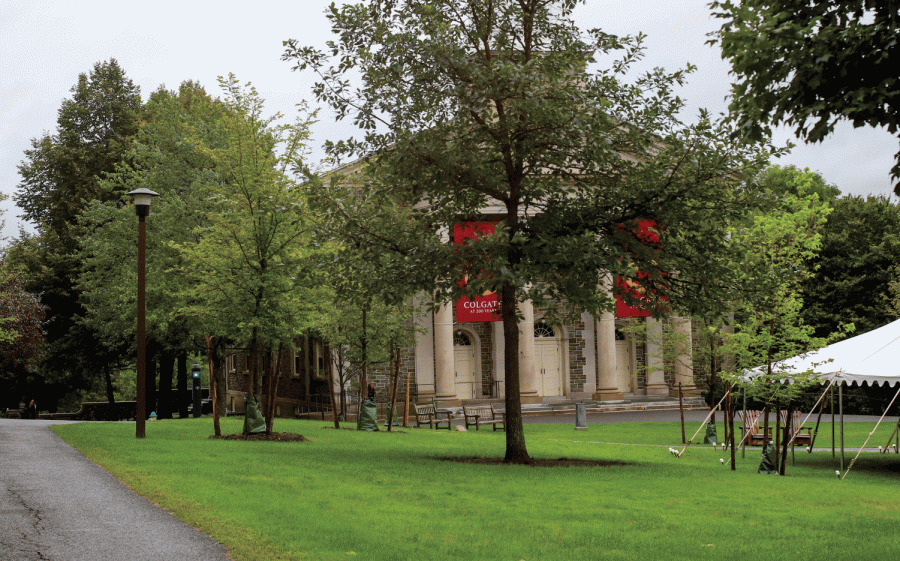Landscaping and Architectural Changes to Campus: Colgate invests $60 million in architectural and landscaping projects in its bicentennial year.
As Colgate embarks on its third century, there are necessary architectural and landscaping additions being met in order to prepare the school for the increasing number of students that will be attending in coming decades – $60 million worth of renovations.
The school has had an uptick in the number of admitted students enrolling to Colgate. The class of 2020 and class of 2021 had 775 and 774 students in their first-year classes, respectively, whereas the class of 2022 had 829 students enroll. Colgate is growing, both in student-population and in the land it is utilizing.
This is where a core value of the university is challenged: sustainability. It’s a difficult task to address when construction-expansion and the environment that surrounds the campus completely oppose each other. These new buildings simply cannot be built without the destruction of some surrounding woodlands, of which Colgate owns over one thousand acres in the area.
With the construction of the two new residence halls, 86 trees were cut down and their materials allocated elsewhere. Throughout this construction process, Colgate calculated the intensive commitment to calculate the environmental impact that this project caused.
By taking into consideration where this wood was going (paper, heating, landfill, building materials etc.), the result was 90.6 metric tons of carbon released into the atmosphere through this project.
To help contextualize this statistic, the calculated amount of carbon emissions in 2017 for the United States was 5,134 million metric tons (according to Reuters). The carbon imprint of this expansion will hinder Colgate’s mission to reach carbon neutrality on campus by 2019.
To mitigate this damage, Colgate has created an opportunity for alumni, family and others affiliated with the school to donate to the bicentennial landscape project. With a donation of $5,000, the donor receives a newly planted tree on campus under their name – which is displayed on a digital map of the school on the Colgate website. Although not all of these trees displayed on the website have been purchased – 24 are being planted this fall because of seasonal reasons – the project will go on for another half-decade. Associate Vice President of Facilities and Capital Projects Stephen Hughes foresees more than 200 trees potentially being donated to the project.
“Arriving back to school this fall, I was shocked when I first saw the quad because of all the new trees that had been planted. It looked so similar but yet so different to the landscape of learning that I’ve spent the last 3 years in,” Colgate’s student body president Jenny Lundt said.
“Though it is different, I fully support the initiatives that have been undertaken to restore the trees that were lost through construction to our campus. That is rarely a fact that is considered in construction and I greatly appreciate the fact that the administration made it a priority moving into the school’s third century. We are nothing if we do not protect the environment around us,” she said.
Apart from taking on the bicentennial landscape project as a means to make amends with construction damage, Colgate is also making strides to ensure that the buildings that are replacing the environment that was once there are as sustainable as possible.
The two new residence halls on campus are being designed by the architectural firm Michael Van Valkenburgh Associates, which has also designed buildings at Amherst, Harvard, Princeton and Vassar. In addition, the firm also served as the architectural landscape firm for the Barack Obama Presidential Center. Each building will contain 100 beds, have nearly 85,000 square feet of real estate combined and will also be home to classrooms, offices and seminar rooms.
As of 2015, Colgate adopted Green Building Standards as a means to become more aware of the continuous impact these buildings have on the environment beyond construction. Green Building Standards focus on a buildings environmental responsibility and resource-efficiency throughout a building’s life-cycle (ie. construction, maintenance, renovation etc). Each new construction or renovation must receive LEED (Leadership in Energy and Environmental Design) certification from the U.S. Green Building Council. For example, the Trudy Fitness Center and Class of 1965 Arena both hold Gold LEED status. The newly constructed Benton Hall has qualified for Gold certification, but could realistically receive platinum: the highest honor for a sustainable building.
The motive behind this entire landscaping initiative is to create a more academically cohesive campus. By providing more space for students, Colgate has the opportunity to facilitate the academic and social community on campus.
Looking toward the future, the school will look into moving vehicles to the perimeter of campus, becoming a safer area for pedestrians and bikers.
With the addition of the new residence halls, more students will have the opportunity to live on the Colgate campus, versus townhouses or apartments, enhancing academic and social continuity.
Contact Nick Francoeur at [email protected].
Nick Francoeur is a junior from Manhattan, New York studying philosophy at Colgate. He’s previously worked as a news writer and assistant news editor....







